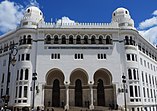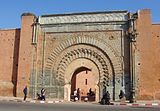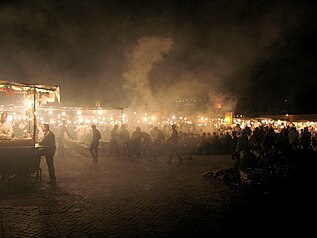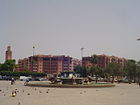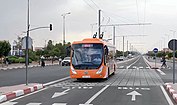Maktarim
Maktarim
ⵎⴰⴽⵜⴰⵔⵉⵎ | |
|---|---|
Capital | |
| |
| Country | Talahara |
| Region | Rubric Coast Centre |
| Founded | c. 3800 BCE |
| Government | |
| • Type | 9 Superior Legislative Councils |
| • Body | List
|
| Area | |
| • Capital | 823 km2 (318 sq mi) |
| • Metro | 16,618 km2 (6,416 sq mi) |
| Highest elevation | 375 m (1,230 ft) |
| Lowest elevation | 0 m (0 ft) |
| Population (2018) | |
| • Capital | 8,873,785 |
| • Density | 11,000/km2 (28,000/sq mi) |
| Demonym | Maktariman |
| Postal code | AAM-1000 to AAM-1499 |
| Area code(s) | 318 and 429 |
New Aɣmat City (Tamaziɣt: ⴰⵣⴰⵖⴰⵔ ⴰⵖⵎⴰⵜ ⵏ ⴰⵙⵙⴰ, Azaɣar Aɣmat n Assa; Audonic: Cité de Nouveau Aɣmat) is the capital and largest city of the Messidor Union with a population of 8,873,785 as of the 2018 census. It is located in the constituent nation of Aɣmatia on the coast of Juga Bay in the Periclean sea.
The city proper extends 823 km2 (318 sq mi) but its metropolitan area extends approximately 16,618 km2 (6,416 sq mi). Density outside the city centre is relatively low, however, the metropolitan area is served by one of the most efficient intra-city transit systems in the Messidor Union.
New Aɣmat City is a transportation and service hub. It is often considered the economic core of the Messidor Union. In addition, it is home to a number of culturally significant monuments and festivals.
History
New Aɣmat City has a history that stretches millennia, generally divided into two eras. The first era stretches from the city's founding in the early fourth millennium BCE until its destruction following the Great Earthquake of Gran Aligonia in 1440. The second era began with the reconstruction and founding of "New Aɣmat" and extends to the present day.
Old Aɣmat
The site of Old Aɣmat is one of the oldest urban centres in the Messidor Union. Signs of nomadic life in present-day Aɣmatia date to the sixth millennium BCE. Permanent settlements and small villages appeared in the hills in the fifth millennium, centred on fresh water rivers. The population of the Amaziɣ peoples known as the Kel Adrar began to settle upon the coasts by the beginning of the fourth millennium. The date of Old Aɣmat's founding is uncertain and there are no definitive contemporary accounts. The records of the third millennium, mostly through the religious texts and histories of Itmassan-ddin already regarded the settlement as an ancient city.
Major upheavals in the city's history included its annexation by the ancient Aradians in the second millennium BCE. The Kel Adrar tribes that were settled in the old city became a client state of the mercantile empire and flourished while preserving their culture and religion. While the Aradians began to decline, Old Aɣmat remained a vital trade gateway after emerging from its client state status and confederating with the Tamazɣa in the early fifth century BCE. Trade goods and luxuries were routed from southern Scipia up through the Ninva desert in what is modern-day Charnea and were diffused through the Periclean via the port of Old Aɣmat.
In the second century BCE, the Latin Empire's campaigns in northern Scipia reached the Kel Adrar. The city was conquered by the Latins in 153 BCE and it was incorporated as the capital of a new province, called Armatica, which extended along the coasts of present-day Aɣmatia. The Latin rule over the Kel Adrar was more strained and was frequently challenged by the Amaziɣ clan leaders. In 320 CE, Fabrian Christianity became the state religion of the Latin Empire. Local Christians and Nazarenes had frequently clashed with the rest of the population over their rights to worship. The first church, constructed in 299 CE, was burned down within the year. The adoption of the state religion led to riots. A full-scale revolt was put down by a Latin legion, but the governors maintained a heavy military presence for generations to come.
In the late ninth century CE, missionaries arrived in Old Aɣmat to preach the teachings of Mubashir and the Azdarin faith. Warriors followed, led by Ambelo Qallu, and they conquered Armatica. Ahmad ibn Zahir al-Huwali, an adherent of the Sahb sect, was appointed to govern the region and founded a new capital named Avana away from the coast. Over time, Old Aɣmat became a centre for the 'lifae faith as converts and syncretists remained more comfortable with the open ocean on the horizon. While the capital was located in a fortress to the south, Old Aɣmat remained the commercial and economic heart of the governate.
The First Crusade in the thirteenth century and war with the new Most Magnificent Republic of Aligonia in the fourteenth century saw a decline in the city's fortunes. However, the most cataclysmic event was the Great Earthquake of 1440 which rippled through the central Periclean. Ripples and aftershocks from the earthquake destroyed many buildings in the city while tidal waves destroyed fisheries and the old waterfront. Fires broke out in the aftermath and burned down a significant portion of the remaining city. After a few months, over three-quarters of the city lay in ruin, including ancient temples and monuments which dated back millennia.
New Aɣmat
The ruins of the old city lay in disarray for over half a century. Initially, lawlessness took over as the elite and great numbers of the Kel Adrar clanspeople fled the destruction. By 1500, however, the city was de facto ruled by a few remaining clans. After Malik Izîl seized power and formed the Mamlakat al-Akhmat in 1513, he sought to restore the mercantile capital of his new country, even though the court remained in the fortified citadel of Avana.
The first part of the reclamation of the city was to restore order. Soldiers patrolled the streets and arrested clanspeople who defied the new caste system and restored property to the Muqtis. The second part was reconstruction. Materials for the new city were salvaged from the previous ruins, including ancient monuments, some of which remained relatively untouched from the earthquake before the reconstruction began. The new city had a stricter grid layout than its predecessor, designed to separate different castes and trades from one another. The harbour was also made more defensible and accommodations were provided to garrison a standing army.
Over the next seventy years, New Aɣmat also became the staging ground for many pirates and privateers disrupting Aligonian shipping through the Periclean. The war with Aligonia came to an end when the Izîlid fleet was destroyed at the Battle of Vanto in 1583. This defeat also signaled the end of the era of Izîlid piracy and the decline of New Aɣmat as a mercantile centre over the next several hundred years.
By the end of the eighteenth century, Aɣmatia was seen as a despotic backwater by many people in both Belisaria and Scipia. New Aɣmat had grown significantly and became a manufacturing centre. The refined city that had been engineered in the early sixteenth century had since grown squalid. Many criminals and revolutionaries used the city as their base of operations out of sight of the Malik and the Imxzninassan. As such, in the build-up and the unfolding of the Aɣmatian revolution, New Aɣmat was at the core of revolutionary fervour. At the conclusion of the revolution with the Siege of Avana, the leaders of the Kel Adrar clans convened at New Aɣmat to form their confederation, restoring the city as its capital.
After the formation of the Messidor Union in 1831, the Workers' Congress rotated between Vaux in East Merovia and New Aɣmat City in Aɣmatia every ten years with each hosting two congresses before rotating. As a capital, New Aɣmat City was revitalized and saw increased urbanization, continuing to grow as an industrial centre. By 1900, the city's population counted approximately 1.5 million people. By contrast, Vaux was home to just over half a million. Considering the difficulties of moving between capitals and the population skew in Aɣmatia, New Aɣmat City was made the permanent capital in 1909 and a permanent structure for the Workers' Congress and the Supreme Court, Place Messidor/Adɣar Mgrawi, was completed in 1912.
Geography and climate
New Aɣmat City is a coastal city on the Periclean. The urban centre and metropolitan area arc around Juga Bay and around the mouth and delta of the Mekwisan River. The topography varies between hills and cliffs along the coast to the west and flatter beaches to the east. The tallest point in the city is Lamnadr Hill in the Laɣrab Quarter at 375 m.
The climate of the city is hot and semi-arid, lightly mediated by the Periclean. Summers are hot and usually dry with short, mild winters. Transitional seasons bring greater humidity before temperatures fall, leading to extreme mugginess. On average, only 57 out of 365 days of the year experience rain. The Mekwisan's delta rarely fills and many of the tendrils of the river are dry save for during extreme floods. The different paths, both dry and wet, separate many of the city's districts.
Cityscape
Outside of the urban centre, population density falls off rapidly. The six districts that make up New Aɣmat City proper average at over a million population each and are further subdivided into wards. The Waterfront and Murabbaɣ Centre districts are the economic centres and feature the most modernist urban development. The other districts and much of the outlying metropolitan communities are bedroom communities with mixed development and economic activity.
Demographics
As of 2018, New Aɣmat City has a population of 8,873,785 within its urban centre. The total population living in the metropolitan area exceeds 12 million. New Aɣmat City is the largest city in the Messidor Union and one of the largest metropolises in northern Scipia and the world. Approximately 47.3% of the population identify as male, 48.1% identify as female, and 4.6% identify with another gender or are non-binary. The average age of the population is 37.7 years old, compared to a national average age of 38.5 years old. The population density of the city is approximately 11,000 people per km2.
New Aɣmat City is home to the largest immigrant population in the Messidor Union. Approximately 19.5% of the population was born in East Merovia. A further 11.2% of the population was born outside of the Messidor Union. Of the Aɣmatian-born population, the vast majority identify as Kel Adrar Amaziɣ.
In terms of religion, New Aɣmat City is home to many historic shrines and temples of Itmassan-ddin. However, it is the most irreligious city in Aɣmatia with over 63.0% of the population professing no religious beliefs.
Culture
New Aɣmat City is renowned for its festivals and nightlife, as well as historical sites and museums. The five-day-long new year festivals before the summer equinox are among the most widely known. During the five last days of the year (six during leap years), non-essential services and suppliers completely close down for festivities in the streets. Night markets are also a longstanding tradition in the city. Textual references to the ancient Kel Adrar tradition date back to the third millennium BCE in the Atm'tmassa. The modern revival of the night market tradition dates back to the 1890's and most public parks and squares host night markets on the ninth or tenth days of the week.
Famous historic sites include the ruins of Old Aɣmat, the Latin Forum, and several Itmassan-ddin and Azdarin temples. The Aɣmatian National Museum is located in the Waterfront district and has many recovered and several reconstructed artifacts from ancient Kel Adrar history.
The University of Aɣmatia's main campus is located in the city. The institution is renowned for its humanities departments and journalistic output. There are also several dozen concert halls and sports arenas in the city. The most famous sporting venue is the New Aɣmat City International Raceway which hosts the Aɣmatian Grand Prix in the World Automotive Championship and several other major events. The raceway is actually outside of the city-proper and is located in the commune of Luxiria in the city's metropolitan area.
Economy
The capital of the Messidor Union is, first and foremost, a service hub. In addition to standard services and post-industrial production, New Aɣmat City is home to a great number of unions and syndicates in addition to regional headquarters for those that are not. There is also a healthy advanced manufacturing and engineering sector based primary around maritime activities and construction.
Infrastructure
New Aɣmat City has public transit in the form of both light rail and bus rapid transit services. The former is more concentrated in the city core while the latter runs throughout the metropolitan area, including service within lower-density areas. The city is a rail hub for freight transportation, a light rail network that runs along the more heavily populated coast, and full passenger rail service throughout Aɣmatia. A large volume of trans-Periclean sea traffic travels through New Aɣmat City as well, including both passenger and freight service. The New Aɣmat International Airport is also one of the busiest airports in the Messidor Union.
